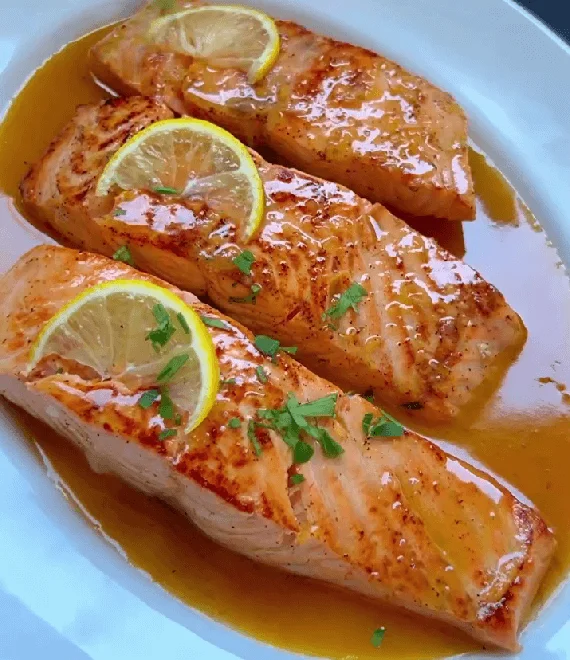Pan Seared Salmon with Citrus Butter Glaze
We may earn a commission from recommended products, at no extra cost to you. See Disclosure.
INGREDIENTS
- 2.2 pounds/kilogram salmon skinless fillets
- 1 teaspoon coarse salt
- ⅓ cup/80 grams butter
- 2 navel oranges, juiced
- 1 teaspoon lemon zest
Toppings:
INSTRUCTIONS
- Sprinkle coarse salt on the salmon pieces on all sides.
- Melt the butter in a large pan over medium heat for about 3 minutes until browned. Add the salmon top side facing down and fry for 3-4 minutes until golden. Add the orange juice and lemon zest and turn the salmon over. Cook for another 4-5 minutes, while basting the salmon pieces with the sauce.
- Transfer to a plate and top with lemon slices and chopped parsley.
MY NOTES

FAQ
WHAT TYPE OF SALMON IS BEST FOR PAN SEARING?
Generally, any type of salmon fillet can be used for pan searing. Popular choices include wild-caught salmon like Chinook (King), Coho (Silver), or Sockeye (Red), as well as farm-raised Atlantic salmon.



How to prevent the salmon fillets from sticking
Preheat the pan: Ensure that your skillet or frying pan is properly preheated before adding the salmon. This helps create a non-stick surface.
Use the right type of pan: A non-stick skillet or well-seasoned cast iron pan can be helpful in preventing sticking.
Oil the pan: Add a thin layer of oil to the pan before placing the salmon fillets. Use an oil with a high smoke point such as vegetable oil, canola oil, or avocado oil. Tilt the pan to evenly coat the surface.
Pat the salmon dry: Before adding the salmon to the pan, make sure to pat it dry with paper towels. Moisture on the surface of the fish can contribute to sticking.
Place the salmon skin-side down (if applicable): If your salmon fillets have skin, start by placing them skin-side down in the pan. The natural oils in the skin can help prevent sticking.
Avoid moving the salmon too soon: Allow the salmon to cook for a few minutes on one side without moving or flipping it. This helps the surface to develop a crust and reduces the likelihood of sticking.
Gently release the salmon: When it’s time to flip the salmon, gently slide a spatula or fish turner underneath the fillets to release them from the pan. Be careful not to force or scrape the fish too aggressively.
Adjust the heat: If the pan is too hot, the salmon may stick. Consider lowering the heat slightly to prevent excessive browning or sticking.



How do I know when the pan seared salmon is cooked?
The cooking time for salmon will vary depending on the thickness of the fillets and your preferred level of doneness. A good indicator of doneness is when the flesh turns opaque and easily flakes with a fork. It is recommended to cook salmon to an internal temperature of 145°F (63°C).

What can I serve with pan seared salmon?
Opt for a vibrant arugula salad dressed with lemon vinaigrette to contrast the salmon’s richness. Roasted asparagus or sautéed spinach provide a tender, flavorful side. Quinoa or wild rice, cooked in broth and herbs, adds depth to the meal. For a more indulgent touch, creamy mashed potatoes or a cauliflower puree complement the salmon’s buttery notes. A side of grilled vegetables—such as zucchini, bell peppers, and carrots—brings a charred, savory dimension.

